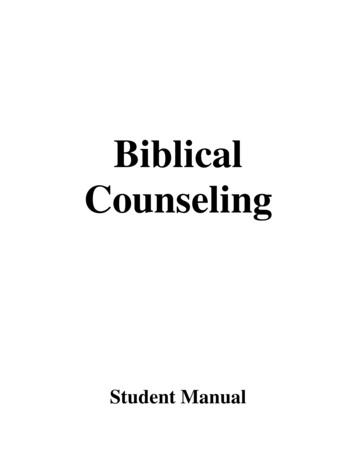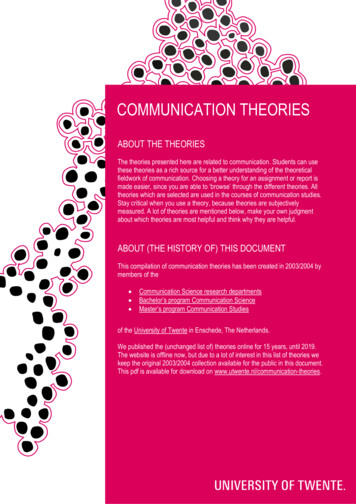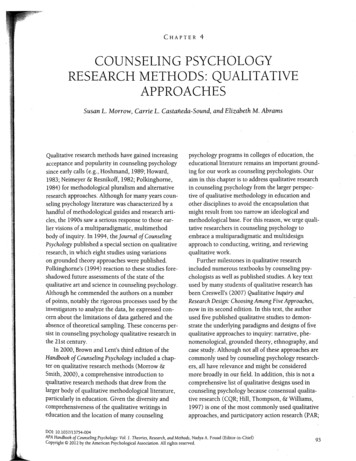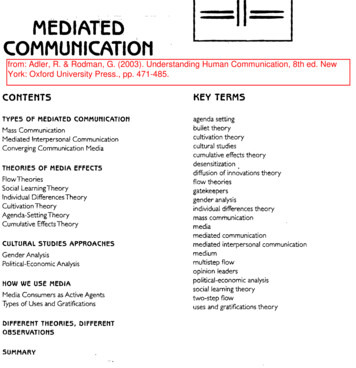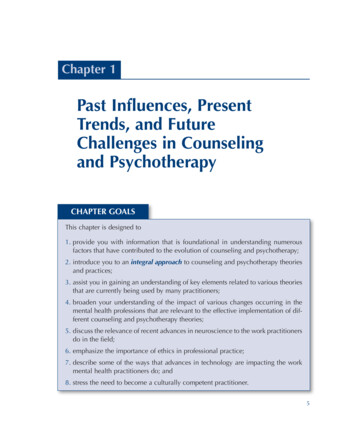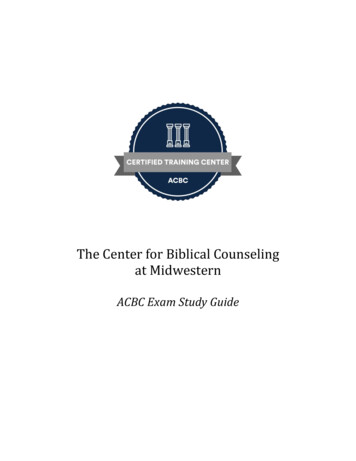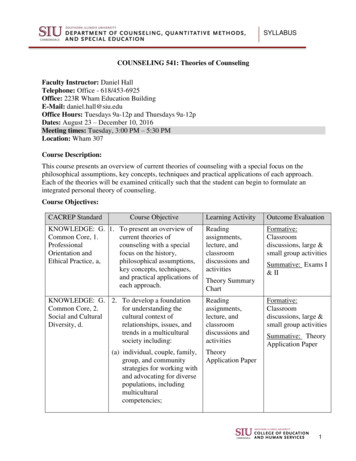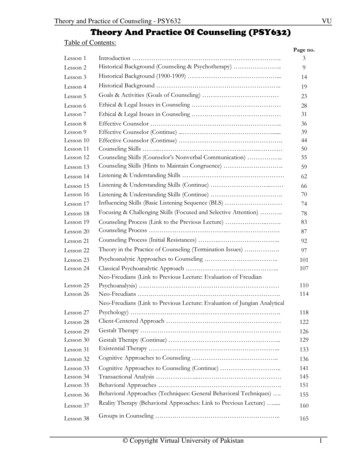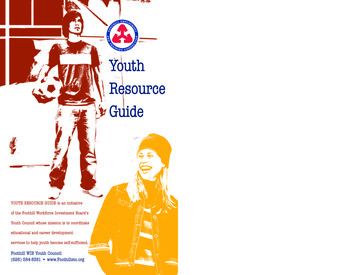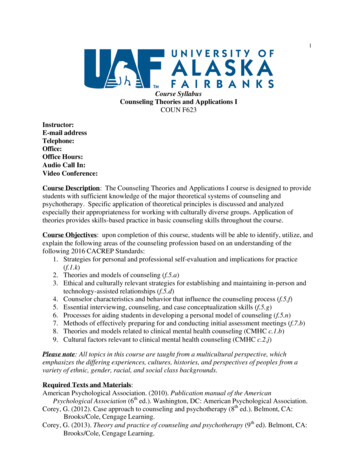
Transcription
1Course SyllabusCounseling Theories and Applications ICOUN F623Instructor:E-mail addressTelephone:Office:Office Hours:Audio Call In:Video Conference:Course Description: The Counseling Theories and Applications I course is designed to providestudents with sufficient knowledge of the major theoretical systems of counseling andpsychotherapy. Specific application of theoretical principles is discussed and analyzedespecially their appropriateness for working with culturally diverse groups. Application oftheories provides skills-based practice in basic counseling skills throughout the course.Course Objectives: upon completion of this course, students will be able to identify, utilize, andexplain the following areas of the counseling profession based on an understanding of thefollowing 2016 CACREP Standards:1. Strategies for personal and professional self-evaluation and implications for practice(f.1.k)2. Theories and models of counseling (f.5.a)3. Ethical and culturally relevant strategies for establishing and maintaining in-person andtechnology-assisted relationships (f.5.d)4. Counselor characteristics and behavior that influence the counseling process (f.5.f)5. Essential interviewing, counseling, and case conceptualization skills (f.5.g)6. Processes for aiding students in developing a personal model of counseling (f.5.n)7. Methods of effectively preparing for and conducting initial assessment meetings (f.7.b)8. Theories and models related to clinical mental health counseling (CMHC c.1.b)9. Cultural factors relevant to clinical mental health counseling (CMHC c.2.j)Please note: All topics in this course are taught from a multicultural perspective, whichemphasizes the differing experiences, cultures, histories, and perspectives of peoples from avariety of ethnic, gender, racial, and social class backgrounds.Required Texts and Materials:American Psychological Association. (2010). Publication manual of the AmericanPsychological Association (6th ed.). Washington, DC: American Psychological Association.Corey, G. (2012). Case approach to counseling and psychotherapy (8th ed.). Belmont, CA:Brooks/Cole, Cengage Learning.Corey, G. (2013). Theory and practice of counseling and psychotherapy (9th ed). Belmont, CA:Brooks/Cole, Cengage Learning.
2Martin, P. (2001). Mixed Emotions: A tool that helps you make decisions, solve problems,resolve conflicts, and more. (Card Set)Recommended Text:Neukrug, E. (2018). Counseling theory and practice (2nd ed.). Belmont, CA: Brooks/Cole,Cengage Learning.Required Readings:Peer reviewed articles and presentation assigned readings will be assigned per the dates on thesyllabus.Beck, A. T. (2005). The current state of cognitive therapy: A 40-year retrospective. Archives ofGeneral Psychiatry, 62, 953-959.Bornstein, R. F. (2005). Reconnecting psychoanalysis to mainstream psychology: Challengesand opportunities. Psychoanalytic Psychology, 22, 323-340.Brown, L. S. (2006). Still subversive after all these years: The relevance of feminist therapy inthe age of evidence-based practice. Psychology of Women Quarterly, 30, 15-24.Combs, G. & Freedman, J. (2012). Narrative, post-structuralism, and social justice: Currentpractices in narrative therapy. The Counseling Psychologist, 40.Day-Vines, N. L., Wood, S. M., Grothaus, T., Craigen, L., Holman, A. (2007). Broaching thesubjects of race, ethnicity, and culture during the counseling process. Journal ofCounseling and Development, 85, 401-409.Heppner, P. H., Rogers, M. E., & Lee, L. A. (1990). Carl Rogers: Reflections on his life. In P. P.Heppner (Ed.), Pioneers in counseling & development: Personal and professionalperspectives (pp. 54-59). Alexandria, VA: American Association for Counseling andDevelopment.McDowell, T. & Hernandez, P. (2010). Decolonizing academia: Intersectionality, participation,accountability in family therapy and counseling. Journal of Feminist Family Therapy, 22,93-111.Neukrug, E., Bayne, H., Dean-Nganga, L., & Pusateri, C. (2013). Creative and novel approachesto empathy: A neo-Rogerian perspective. Journal of Mental Health Counseling, 35, 2942.Shadish, W. R., & Baldwin, S. A. (2003). Meta-analysis of MFT intervention. Journal of Maritaland Family Therapy, 29, 547-570.Skovholt, T. M., Starkey, M. (2010). The three legs of the practitioner’s learning stool: Practice,research/theory, and personal life. Journal of Contemporary Psychotherapy, 40, 125-130.Spillers, C. (2007). An existential framework for understanding the counseling needs of clients.American Journal of Speech-Language Pathology, 16, 191-197.Westen, D. (1998). The scientific legacy of Sigmund Freud: Toward a psychodynamicallyinformed psychological science. Psychological Bulletin, 124, 333-371.Wilson, K. G. (1997). Science and treatment development: Lessons from the history of behaviortherapy. Behavior Therapy, 28, 547-558.(All required readings are in the dated file folders under the Session Resources section ofBlackboard or available from the Rasmuson Library.)
3Course Instructional Methods:The following methods will be used throughout the course: didactic instruction, guidedinstruction, video, live demonstration, role playing, small group projects, studentpresentations, and structured group exercises. Most classes will follow thisformat/schedule:I.Review prior class material/Check-in re: questionsII.Didactic Instruction followed by structured exercise/small group discussionIII.BreakIV.Activity/Student PresentationorV.Counseling SessionsCourse Evaluation: Students will be evaluated based on following criteria:1. Class Attendance and Participation: Students are expected to come to class prepared,with assignments turned in prior to arrival. Be ready to begin promptly at 4:15 PM.Two percent (2%) will automatically be deducted from a student’s final grade formissing one class, and 1% will be deducted for arriving late or leaving early. If missingclass is unavoidable, I must be notified before the class session. If your absence isexcused, you can make up the 3% by completing a four-page summary reflection onwhat you missed in class based on readings and speaking with other students.Absence does not relieve a student’s responsibility of completing all assignments beforethe due date, or for comprehending the material presented during the class session.Missing more than one class may result in the student receiving a grade of“Incomplete” or failure (“F”) of the course.Reading assignments and participating in class discussions is expected. Your attendanceand the quality of your involvement in class are worth a maximum of 50 points towardyour final grade. A rubric located at the end of the syllabus further delineates how youwill be evaluated. Speak out and share your perspectives; it enriches the classexperience for all of us! Blackboard Discussion Introduction and Student and Faculty LearningAgreement: Post a one (1) paragraph introduction of yourself on the introductionblackboard discussion board. This introduction should share your counselingtrack, what interests you about this course, a fact about you, and a picture ofyourself. In addition, read and sign the “Student and Faculty LearningAgreement” located under the Assignments tab.2. Blackboard Reflections: Reflections on readings assigned each week will be due nolater than Sunday evening each week before the class on the assigned material onblackboard by 11:59PM Alaska time. The thirteen (13) weekly reflections will need tobe at least 300 words in length and posted on blackboard. Reflections will need to bethoughtful and cite and reference specific material for each theory that was covered in thereadings assigned for the week of the assignment. Critical reflection and thought onmaterial and in class discussions is required. Discussion board posts are to be written infirst person and points will be lost for content, length, grammar/punctuation, and APAreference/citation errors. APA 6th edition citations and references are required. Eachperson is required to respond to two other posts with a thoughtful critical thinking
4response of at least 100 words, by Wednesday evening of week each week onblackboard discussion board by 11:59PM Alaska time.3. Case Study Conceptualization Paper: This paper is designed to allow students toexplore and synthesize the initial assessment and walkthrough of a case conceptualizationusing one of available theoretical case studies of “Ruth” in the Case approach tocounseling and psychotherapy text. Students will write a minimum of three (3) pages,either in first or third person. Points will be lost for content, page length,grammar/punctuation, and APA style errors. Example and more information will beprovided on Blackboard.4. Counseling Theory Demonstration and Techniques Group Presentation:Presentations will be two-parts:a. Students will record and present a 15-minute role-play demonstration of thetheory.b. Students will present the therapeutic techniques and procedures utilized in thistheory as well as facilitate an in-class discussion. This part of the presentation willbe about 20-minutes in length.The presentation and discussion will be based on additional readings that advance theknowledge your classmates have already attained from the already assigned coursereadings. A minimum of two selected readings of the particular theorist and/or approach(written by the theorist themselves if available) are required from the presenters and needto be provided to the instructor at least one week before the presentation.Each presentation will correspond with the assigned theory of the week, be no less than35 minutes in length, and will include a handout for students in the class. The handoutshould be a professional synopsis of the essential information on the chosen theory andinclude detailed suggestions for using this specific theoretical orientation. The handoutwill be graded on APA style references, content, and creativity. Handouts must besubmitted to blackboard no later than 11:59PM Alaska Time the day before thepresentationEach presentation must utilize technology to record the role-play (suggestions will begiven in-class), and Microsoft PowerPoint or similar program the presentation portion(you may utilize additional technology and/or audiovisual aids during the presentation).Students will sign-up for presentation groups on the first day of class to present andgroups will consist of two (2) to three (3) students based on the number of studentsenrolled in the course.5. Counseling Sessions: Students will conduct ten (10) role-play sessions, five (5) sessionsas the counselor as five (5) sessions as the client, throughout the semester. The goal ofthese sessions is to build client rapport, practice basic counseling skills, apply theorytechniques, and complete client paperwork and skills evaluation. Time will be allottedduring each class to complete each session. Each session will be recorded, and paperworkwill need to be completed for each session. Grading for counseling sessions will includethe following required components of this assignment:a. Students must complete all ten (10) practice role-play sessions. Sessionswill be completed either in-person (if enrolled locally) in the counselingclinic (in assigned pairs), or through distance learning software (for those
5enrolled as DL students). All sessions must be recorded. If you are an oncampus student, you can record in the clinic, but it is recommended thatyou record from your laptop (there will be instructions). If you are a DLstudent, you will be using YouTube Live to meet with your volunteerclients. DL students will be required to record each session throughYouTube Live (Instructions are located on Blackboard).b. Students must complete the following required documents for each sessionthat they are a counselor:i. Session One1. Intake: Complete intake from your own session as thecounselor.ii. Session Two1. Session analysis: Complete a session analysis of your ownsession as a counselor.2. Progress note: Complete a progress note of your ownsessioniii. Session Three1. Peer analysis Observation: Complete an observationanalysis of your peer partner’s session.iv. Session Four1. Session Analysis: Complete a session analysis of your ownsession as a counselor2. Peer Analysis Observation Form: Complete an observationof your peer partner’s sessionv. Session Five1. Session Analysis: Complete a session analysis of your ownsession as a counselor2. Peer Analysis Observation Form: Complete an observationof your peer partner’s session3. Progress note: Complete a progress note of your ownsessionc. Students will be required to practice and demonstrate micro-skills in eachof the five sessions. Evaluation will occur through self and pairedevaluation.d. Counseling session paperwork is due no later than the dates on thesyllabus calendar.6. Verbatim Transcription: After the fourth counseling session, students will be requiredto complete one thirty (30) minute verbatim transcription of the session that includesidentification of skills and self-awareness, and the counselor and client response.7. Final Paper Outline: An outline for the final paper (including references to be used inyour paper), which needs to include enough information to show you have gatheredinformation for each section.8. Final Theoretical Orientation Paper: This paper is designed to allow students toexplore and synthesize what has been learned over the length of this course byformulating your own theoretical working model of counseling. You are to demonstratethe applicability of the theory through self-analysis of one life stage (i.e., childhood,
6adolescence, adulthood) of your choice. You will also need to include how your theoryconceptualizes the individual, how therapeutic change occurs, and what constitutespsychopathology, using supplemental resources as necessary. At least ten (10) outsideresources must be used and cited appropriately. Writing should conform to APA style (6thed.) and include citations and references. This paper is to be written in third person.You are encouraged to use the Writing Center for assistance in any stage of thisassignment. You may want to talk with someone there while you are in the planningstages for your paper. The paper should be 14-16 pages in length (not including titlepage and references) and include at least ten peer-reviewed references (notincluding textbooks).Grades:Your course grade will be determined bythe following point system:Class Attendance/Participation50 pointsWeekly Reflections (13 at 5 points)65 pointsCounseling Theory Presentation70 pointsCase Study Conceptualization25 pointsFinal Paper Outline10 pointsFinal Theoretical Orientation Paper125 pointsVerbatim Transcription55 pointsCounseling Session Paperwork100 pointsTotal500 pointsGrading Scale465 points and up (93%)450-464.9 points (90-92.9%)440-449.9 points (88-89.8%)415-439.9 points (83-87.9%)400-414.9 points (80-82.9%)390-399.9 points (78-79.9%)365-389.9 points (73-77.9%)360-364.9 points (70%-72.99%)340-359.9 points (68-69.9%)315-339.9 points (63-67.9%)300-314.4 points (60-62.9%)Less than 300 pointsAAB BBC CCD DDFDisability Services: Students with a physical or learning disability, who may need academicaccommodations, should contact the Disability Services office. UAF Disability Services islocated within the Center for Health and Counseling in the Whitaker Building on the corner ofYukon Drive and North Chandalar (Room 208). The accessible entrance is located on NorthChandalar Drive. UAF Disability Services can be contacted by telephone (474-5655) or e-mail(uaf-disabilityservices@alaska.edu). Once documentation of your disability is received,Disability Services will contact me regarding the necessary accommodations.Support Services: Writing support services are available on the UAF Campus in the WritingCenter, located in 801 Gruening, UAF, 907-474-5314, and on the UAA Campus at theReading/Writing Center, located in 118 Sally Monserud Hall, UAA, 907-786-6918. Note: toaccess this Center at UAA, students must register in the English Department (907-786-4355) at arate of 12 per semester. Students who are not on the UAA or UAF campus should contact theCenter for Distance Education for details regarding support services that are available bydistance.Plagiarism. Plagiarism is representing someone else's ideas and work as your own. Plagiarismincludes not only copying verbatim, but also rephrasing the ideas of another without properlyacknowledging the source. As you prepare and submit work to meet course requirements,whether a draft or a final version of a paper or project, you must take great care to distinguish
7your own ideas and language from information derived from sources. Sources include publishedprimary and secondary materials, electronic media, and information and opinions gaineddirectly from other people.The University of Alaska Board of Regents has clearly stated in BOR Policy that discrimination, harassment andviolence will not be tolerated on any campus of the University of Alaska If you believe you are experiencingdiscrimination or any form of harassment including sexual harassment/misconduct/assault, you are encouragedto report that behavior. If you report to a faculty member or any university employee, they must notify the UAFTitle IX Coordinator about the basic facts of the incident. Your choices for reporting include: 1) You may accessconfidential counseling by contacting the UAF Health & Counseling Center at 474-7043; 2) You may accesssupport and file a Title IX report by contacting the UAF Title IX Coordinator at 474-6600; 3) You may file acriminal complaint by contacting the University Police Department at 474-7721.
8Class Schedule, Required Readings, Assignment Due DatesAdditional work may be assigned to meet course requirements.ClassWeek/Date1Class ContentCourse OverviewIntroductionsCounseling TheoriesIntroductionReadingsCorey (2013) Ch. 1, Ch. 2Corey (2012) Ch. 1AssignmentsSign-up for Presentationsvia Blackboard no later than8/31 at 11:59 Alaska TimeIntroductions and Studentand Faculty LearningAgreement on Blackboarddue no later than 8/31 at11:59 Alaska TimeNo Class!3Counseling EthicsBuilding ClientRapportCorey (2013) Ch. 3Corey (2012) Ch. 1Westen (1998)Day-Vines et al. yCorey (2013) Ch. 7Corey (2012) Ch. 5Neukrug, Bayne, DeanNganga, & Pusateri (2013)Heppner, Rogers (1990)Carl Rogers/Gloria Video(See Blackboard for weblink)Corey (2013) Ch. 4Corey (2012) Ch. 2Bornstein (2005)Existential Therapyf.5.a; f.5.d;f.5.f; f.5.g;CHMC.c.1.b;CHMC.c.2.jReflection #1 (CounselingTheories Introduction) DueFriday, 8/31 at 11:59Alaska TimeReflection #1 Response DueWednesday, 9/5 at 11:59Alaska Time25CACREP 2016StandardsCorey (2013) Ch.6Corey (2012) Ch. 4Spillers (2007)Presentation AssignedReadings (see blackboard)Reflection #2 (CounselingEthics, Building ClientRapport) Due Sunday, 9/9at 11:59 Alaska TimeReflection #2 Response DueWednesday, 9/12 at 11:59Alaska TimeReflection #3 (PersonCentered Therapy) DueSunday, 9/16 at 11:59Alaska TimeReflection #3 Response DueWednesday, 9/19 at 11:59Alaska Timef.5.a; f.5.d;f.5.f; f.5.g;CHMC.c.1.b;CHMC.c.2.j1a Counseling Session1b Counseling Sessionf.5.a; f.5.d;f.5.f; f.5.g;CHMC.c.1.b;CHMC.c.2.jReflection #4(Psychoanalytic) DueSunday, 9/24 at 11:59Alaska TimeReflection #4 Response DueWednesday, 9/26 at 11:59Alaska Time2a Counseling SessionReflection #5 (Existential)Due Sunday, 9/30 at 11:59Alaska TimeReflection #5 Response Duef.5.a; f.5.d;f.5.f; f.5.g;CHMC.c.1.b;CHMC.c.2.jf.1.k; f.5.a;f.5.d; f.5.f;f.5.g;f.5.n;f.7.b;CHMC.c.1.b;
9678Adlerian TherapyGestalt TherapyPost-ModernApproaches (IncludingNarrative Therapy)Corey (2013) Ch. 5Corey (2012) Ch. 3Presentation AssignedReadings (see blackboard)Corey (2013) Ch. 8Corey (2012) Ch. 6Fritz Pearls/Gloria Video(See Blackboard for weblink)Presentation AssignedReadings (see blackboard)Corey (2013) Ch.13Corey (2012) Ch. 11Combs & Freedman (2012)Presentation AssignedReadings (see blackboard)Wednesday, 10/3 at 11:59Alaska TimeCMHC.c.2.2b Counseling Sessionf.1.k; f.5.a;f.5.d; n 1 Paperwork Due10/8 at 11:59 Alaska TimeReflection #6 (Adlerian)Due Sunday, 10/7 at 11:59Alaska TimeReflection #6 ResponseDue Wednesday, 10/10 at11:59 Alaska Time3a Counseling SessionCase StudyConceptualization PaperDue Sunday, 10/14 at 11:59Alaska TimeReflection #7 (Gestalt) DueSunday, 10/14 at 11:59Alaska TimeReflection #7 Response DueWednesday, 10/17 at 11:59Alaska Time3b Counseling SessionSession 2 Paperwork Due10/22 at 11:59 Alaska TimeReflection #8 (Post-ModernApproaches) Due Sunday,10/21 at 11:59 Alaska TimeReflection #8 Response DueWednesday, 10/24 at 11:59Alaska Time910Cognitive-BehavioralTherapyBehavior TherapyCorey (2013) Ch. 10Corey (2012) Ch. 8Beck (2005)Albert Ellis/Gloria Video(See Blackboard for weblink)PresentationAssignedReadings (see blackboard)Corey (2013) Ch. 9Corey (2012) Ch. 7Wilson (1997)Presentation AssignedReadings (see blackboard)4a Counseling SessionReflection #9 (CBT) DueSunday, 10/28 at 11:59Alaska TimeReflection #9 Response DueWednesday, 10/31 at 11:59Alaska Time4b Counseling SessionSession 3 Paperwork Due11/5 at 11:59 Alaska TimeFinal Paper Outline Due11/5 at 11:59 Alaska TimeReflection #10 (Behavior)Due Sunday, 11/4 at 11:59f.1.k; f.5.a;f.5.d; f.5.f;f.5.g;f.5.n;f.7.b;CHMC.c.1.b;CMHC.c.2.f.1.k; f.5.a;f.5.d; f.5.f;f.5.g;f.5.n;f.7.b;CHMC.c.1.b;CMHC.c.2.f.1.k; f.5.a;f.5.d; f.5.f;f.5.g;f.5.n;f.7.b;CHMC.c.1.b;CMHC.c.2.f.1.k; f.5.a;f.5.d; f.5.f;f.5.g;f.5.n;f.7.b;CHMC.c.1.b;CMHC.c.2.
10Alaska TimeReflection #10 ResponseDue Wednesday, 11/7 at11:59 Alaska Time11Feminist TherapyCorey (2013) Ch. 12Corey (2012) Ch. 10Brown (2006)McDowell & Hernandez(2010)5a Counseling Session5b Counseling SessionSession 4 Paperwork Due11/12 at 11:59 Alaska TimeVerbatim TranscriptionDue 11/12 at 11:59pmAlaska Time121314Reality TherapyCorey (2013) Ch.11Corey (2012) Ch. 9Online LearningActivityNo In-Class MeetingFamily SystemsTherapyCorey (2012) Ch. 12Corey (2013) Ch. 14Shadish & Baldwin (2003)Integration ofCounseling TheoriesCorey (2013) Ch.15 & 16Evaluation ComponentReflection PapersCounseling Theory PresentationCase Study ConceptualizationCounseling Sessions/PaperworkSession Three Verbatim TranscriptionFinal Theoretical Orientation PaperReflection #11 (Feminist)Due Sunday, 11/11 at 11:59Alaska TimeReflection #11 ResponseDue Wednesday, 11/14 at11:59 Alaska TimeReflection #12 (Reality)Due Sunday, 11/18 at 11:59Alaska TimeReflection #12 ResponseDue Wednesday, 11/21 at11:59 Alaska TimeSession 5 Paperwork Due11/28 at 11:59 Alaska TimeReflection #13 Due Sunday,11/25 at 11:59 Alaska TimeReflection #13 ResponseDue Wednesday, 11/28 at11:59 Alaska TimeFinal Paper Due viablackboard 12/7 at11:59pm Alaska Timef.1.k; f.5.a;f.5.d; f.5.f;f.5.g;f.5.n;f.7.b;CHMC.c.1.b;CMHC.c.2.f.1.k; f.5.a; f.5.d;f.5.f; f.5.g;f.5.n;f.7.b;CHMC.c.1.b;CMHC.c.2.f.1.k; f.5.a;CHMC.c.1.b;CHMC.c.2.jf.1.k; f.5.a; f.5.d;f.5.f; f.5.n;CHMC.c.1.b;CHMC.c.2.jCACREP 2016 Standard Assessedf.1.k; f.5.a; CHMC.c.1.b;CHMC.c.2.jf.5.a; f.5.d; f.5.f; f.5.g; CHMC.c.1.b;CHMC.c.2.jf.5.a; f.5.f; f.5.g; f.7.b CHMC.c.1.b;CHMC.c.2.jf.1.k; f.5.a; f.5.d; f.5.f; f.5.g;f.5.n;f.7.b; CHMC.c.1.b; CMHC.c.2.jf.1.k; f.5.f;f.1.k; f.5.a; f.5.d; f.5.f; f.5.n;CHMC.c.1.b; CMHC.c.2.j
11Course RubricsAttendance and ISHEDATTENDANCEIs often late for classand leaves earlywithout priorarrangement.Attends all classes. Nomissed classes withoutprior arrangement.Attends all classes. Nomissed classes withoutprior arrangement.Engages otherstudents before andafter class and duringbreaks.LARGE GROUPPARTICIPATIONDoes not ask questionsor make commentsthat indicate familiaritywith class topics.SMALL GROUPPARTICIPATIONDoes not participateactively in smallgroups.Misses no morethan one classwithout priorarrangement. Isnever late anddoes not leaveearly withoutpriorarrangement.Rarely asksquestions ormakes commentsthat indicatefamiliarity withthe class topics.Rarelyparticipatesactively in smallgroups.Occasionally asksquestions or makescomments thatindicate reflection andfamiliarity with theclass topics.Participates in smallgroups.BLACKBOARDPARTICIPATIONDoes not openBlackboard to accessinformation.Rarely opensBlackboard toaccessinformation.Regularly usesBlackboard to enhancethe classroomexperience.Regularly asksquestions or makesobservations thatindicate reflection andfamiliarity with theclass topics.Actively participatesin small groups and isadequately prepared todiscuss the classtopics.Actively usesBlackboard to enhancethe classroomexperience.
12Papers and DCLARITYThe paper isincomprehensibleeven after repeatedreadings.Most of the paperiscomprehensible,but somepassages requireinterpretation bythe reader. Somepassages havepoor organization.The paper iscomprehensible, butthere are a fewpassages that aredifficult to understand.The organization isgenerally good.The paper is easy tounderstand; it isconcise and wellorganized.GRAMMARThe paper has manygrammatical errors.The errors interferewith comprehension.The paper has a fewmajor grammaticalerrors, but the errorsdo not significantlyinterfere withcomprehension.The paper has nomajor grammaticalerrors.AUDIENCEThere is little evidenceof writing forscholar/practitioners;much of the paperincludes colloquialexpressions, use offirst person, etc.The paper does notaddress all the areasrequired by theassignment.The paper has anumber of majorgrammaticalerrors. Some ofthe errorsinterfere withcomprehensionMany parts of thepaper includecolloquialexpressions, theuse of firstperson, etc.The paper is generallywritten forscholar/practitioners,but it includes somecolloquial expressions,the use of first person,etc.The paper addressesall of the areasrequired by theassignment.The paper is ENESSThe paper presents asignificant amount ofirrelevant information.APAFORMATTINGThe paper has manydepartures from theAPA PublicationManual, 6th Edition.The paperaddresses most ofthe areas requiredby theassignmentThe papercontains someirrelevantinformation.The paper hassome departuresfrom the APAPublicationManualThe paper containsirrelevant informationbut the informationdoes not significantlycompromise the paper.The paper has a smallnumber of departuresfrom the APAPublication Manual.The paper addressesall of the areasrequired by theassignment in anengaging manner.The paper has noirrelevant information.The paper is written inaccordance with theAPA PublicationManual.
13Presentation RubricKNOWLEDGE OFMATERIALUnsatisfactoryThe presentersappear to lack abasicunderstanding ofthe topic.BasicThe presenters havea basicunderstanding of thetopic.ProficientThe presenters havea very goodunderstanding of thetopic.RESOURCESNo outside peerreviewed resourcesare used.At least two outsidepeer-reviewedresources are usedappropriately.PRESENTERPARTICIPATIONSome members ofthe presentationteam do not appearto participate.CHOICE OFTEACHING TOOLSTeaching tools arenot creative,effective, and do notmake sense for thepresentationmaterial.USE OF TEACHINGTOOLSOnly one teachingtool is used.ROLE-PLAYThe role-play is notpresent or does notdirectly relate to thetheory.HANDOUTThe handout is notpresent or lackspertinentinformation such asreferences used.Although twooutside resourcesare used, they are allnot peer-reviewed,come directly fromthe theorist, or donot adequatelyconnect to thematerial.All members of thepresentation teamparticipate, butsome are not asinvolved as others.Teaching tools aresomewhat creative,somewhat effective,and generally makesense for thepresentationmaterial.More than oneteaching tool is usedbut there is a lack ofcohesion betweenthe two tools.The role-play ispresent but isminimallyconnected ormissing essentialelements of thetheory.The handout ispresent but does notadequately addressthe topic, is missingcomponents, is notcreative in nature, orhas multiple errors.All member of thepresentation teamparticipate equally.Teaching tools arecreative, effective,and make sense forthe presentationmaterial.Two or moreteaching tools areused togethereffectively.The role-play ispresent and isadequatelyconnected to thetheory.The handout is usedeffectively forpresentinginformation, hasAPA references,and is creative.DistinguishedThe presenters havean excellentunderstanding of thetopic and includeextra information inthe presentation.Two or more peerreviewed resourcesare used in anengaging mannerthat adds depth tothe presentation.All members of thepresentation teampresent equally andthe members appearto work as a team.Teaching tools areexceedinglycreative, effective,and enhances thequality of thepresentationmaterial.Two or moreteaching tools areused together with ahigh level ofaudience response.The role-play ispresent,exceptionallyweaved into thepresentation, anddirectly applies tothe theory.The handout standsout as a thoroughand creativedocument that iserror free andengaging to thereader.
Counseling Sessions: Students will conduct ten (10) role-play sessions, five (5) sessions as the counselor as five (5) sessions as the client, throughout the semester. The goal of these sessions is to build client rapport, practice basic counseling skills, apply theory techniq
